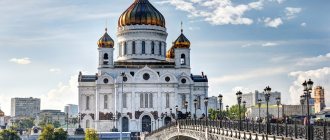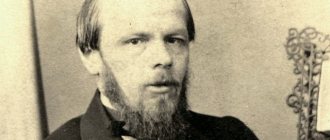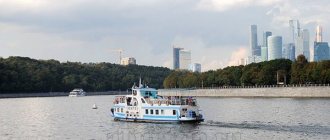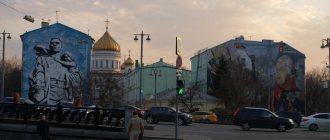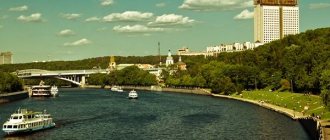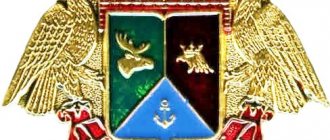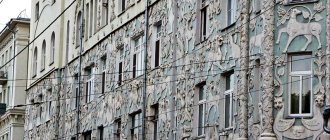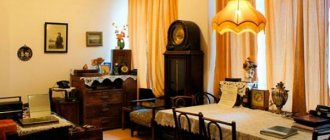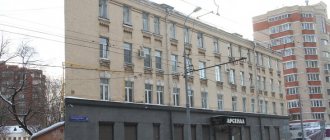Vysoko-Petrovsky Monastery today
The Vysoko-Petrovsky Moscow Monastery is a complex consisting of the following objects:
- Secret building.
- Fountain.
- South Gate.
- Abbot's corps.
- Gallery.
- Belfry.
- Former profitable monastery house.
In addition, on the territory of the Lavra there are the following temples and chapels:
- Chapel of the Naryshkin family.
- Cathedral of St. Petra.
- Church of St. apostles Paul and Peter.
- Cell church in a secret building.
- Above the South Gate is the temple of St. Great Pachomius.
- Sergievskaya Church.
- Church named after Icons of the Mother of God of Bogolyubskaya.
- Chapel of the Kazan Icon.
- Church in honor of the Tolga Icon of the Mother of God.
- Church of the Intercession of the Blessed Virgin Mary.
On the territory belonging to the monastery there is a service building dating from 1690. Along it stands a 17th-century fence, which is also considered to be of architectural value. In 2009, Bishop Mercury of Zaraisk submitted a request to resume spiritual activity in the Vysoko-Petrovsky Monastery. The Holy Synod granted his request on October 10 of the same year.
Since 2010, the monastery has been active, and its brethren number 10 monastics. The entire complex occupies an important place in the Orthodox world. Not only tourists come here, but also numerous pilgrims from all over the world.
Family burial vault of the Naryshkins - Vysoko-Petrovsky Monastery
Moscow is amazing, it is beautiful and unique in its historical charm. You will have to spend many years studying its history and urban legends. Just a few steps from the Kremlin, at the address: Petrovka Street, building 28, building 3, is the Vysoko-Petrovsky Monastery, dating back to the beginning of the 14th century.
The Vysoko-Petrovsky Monastery is located within the Garden Ring on Petrovka Street. Getting there will not be difficult even for “avid Susanin”. You just have to walk along the right side of the street from the Bolshoi Theater. The tall red brick tower will immediately tell the curious traveler where to go and when to stop.
“Free Workshops” is one of the landmarks - you have reached the desired place. They are located just opposite the holy monastery. In their yard there are iron and sometimes strange figures. This is one of the clear examples of the embodiment of the artist’s inner world.
Another, and most delicious, reference point is a small bakery with a simple name: “Monastery Pastries”. Through it you can freely enter the monastery territory. To begin with, you should buy something edible. The bakery sells pies with and without fillings, sweet fudge, Pavlova marshmallow rings, jam and even honey.
The Vysoko-Petrovsky Monastery does not impress with its large size. At every step you can see something interesting, every stone keeps a story. Now a large-scale restoration has been completed in the Cathedral in the name of St. Peter, Metropolitan of Moscow and All Rus'.
A black plaque on the wall of the cathedral suggests that it was built by Aleviz Fryazin Novy in 1517. Until this time, the buildings on this site were wooden. Now we can see an octagonal tower with semicircles, which is not typical for European Rus' in the Renaissance architecture of that time.
If you walk on the right side, then the Temple of St. Sergius of Radonezh appears on the way. There are many entrances. Unknowingly, you can go to the refectory as an option. However, the main thing is the one that leads up the steps. Parishioners here can take candles and go to the next room, which is painted by an unknown artist.
There are several shrines in the temple. Nevertheless, believers especially venerate and worship before the relics of St. Peter, Metropolitan of Kyiv, Moscow and All Rus', the Wonderworker. Every morning at 07:00 in front of the image of St. Peter, who is depicted in full growth, a fraternal rule with a prayer service is performed.
Another interesting place in the monastery ensemble is the Church of the Bogolyubskaya Mother of God. It was built by the mother of Peter the Great, Natalya Naryshkina. The temple is not operational because it is dilapidated and needs restoration.
This sanctuary is interesting because it is the cradle of the Naryshkin family. The temple was built after well-known events - the Streltsy riot in 1682. According to history, the archers came to the Kremlin and tore apart his uncles before the eyes of the still young Peter.
However, you can still go inside the Church of the Bogolyubskaya Mother of God - accompanied by a local guide. Tours run until midnight. The last one starts at 23:00.
There are several guides in the monastery. According to the instructions of my friends, I wanted to get to a tour guide named Bogdan. A young man in a black cassock easily and interestingly talked about the history of every corner of the monastery ensemble.
Some episodes of the story are surprising. For example, Bogdan said that during the capture of Moscow by Napoleonic troops, the monastery was occupied by the French. They set up a meat shop in the Church of the Bogolyubskaya Mother of God.
When the occupiers learned about the burial of the Naryshkins in the holy monastery, the French began to open the floors. As the guide said, they were trying to find not only the burials of the old boyar family, but also jewelry. As a result, the graves were found and the ornate tombstones remained worn reminders with broken tablets.
The tombstones are now located behind the Temple of St. Sergius of Radonezh.
“I see light at the end of the tunnel,” this is how one can describe the feeling of walking through a dark corridor in sunny weather. And it seems like you come out into the light and see the temple of Peter and Paul on a hill (the shrine is also called the temple of Pachomius), but then you turn your head, and the stone sarcophagi of the Naryshkins appear before you.
Rough white stone tombs of various sizes are located on supports. You can see frequent cracks and splits on the worn surface - now it is no longer clear who exactly is buried in them. You can also see corrugated stone cobblestones with rare drawings and inscriptions next to the tombs.
The Naryshkins' house is very close to the monastery. At first he only adjoined him. In the end, the Naryshkin chambers were donated to the holy monastery. Thus, the territory of the Vysoko-Petrovsky Monastery doubled and became a burial vault for the boyar family.
Nevertheless, the memory of the Naryshkins remained not only in history, but also in architecture in the form of a name - “Naryshkin baroque”. It is also called “Moscow”. This name appeared at the end of the 17th and beginning of the 17th centuries and represents a combination of different architectural styles from Old Russian stone architecture to Renaissance and Gothic. It is also characterized by multi-tiered design.
The Naryshkin style is also present in other architectural buildings, such as the Novodevichy Convent, the Krutitsky Compound, the Moscow Church of the Intercession in Fili. Moscow baroque also leaked beyond the capital. In the city of Ryazan, for example, the Assumption Cathedral was built next to the Kremlin. Moreover, there are other buildings: the Gate Church of John the Baptist in the Solotchinsky Monastery and the Boris and Glebov Cathedral.
Shiryaeva Anastasia, photo and video by the author.
Architect, exterior decoration, architectural ensemble
Vysoko-Petrovsky Monastery consists of buildings that are architectural monuments. All of them were built over a long period of time and relate to specific events. The monastery was founded by Metropolitan Peter. Here he moved the metropolitan see from the city of Vladimir to the capital of Russia. The architect of the monastery is the Italian A.F. Novy.
The architecture of the ensemble combines Baroque elements. The Church of Metropolitan Peter is presented in the form of an eight-leaf clover. This form is exclusive to buildings built in 1510. The Cathedral of Metropolitan Peter is one of the first pillar-shaped churches in Russian architecture. Later, other buildings appeared on the territory of the monastery, which make up its current ensemble.
It includes:
- Cathedral of the Bogolyubsk Icon of the Mother of God . The date of its foundation is 84, XVII century. Meets all the canons of temple buildings from the 17th century. The design of the facade consists of a crepe-branched cornice and paired columns. The windows are framed by keeled kokoshniks.
- Church of Sergius of Radonezh (1690-1702). It was built in the style of temple buildings of that time. A distinctive feature indicating the origin of the Moscow Baroque is red brick, which became the main material for the construction of the temple. External decorative elements are made of light stone, which visually adds elegance to the building.
- Church of the Tolga Icon of the Mother of God (1774-1750). A rectangular single-domed temple, with a pentagonal ledge made in the Baroque manner, is located near the Fraternal Building. The decor of the external walls consists of paired semi-columns. Narrow windows are cut out in the dome and decorated with volutes - spiral-shaped curls with a peephole in the center. It is unknown who exactly owned the project of this temple. Many historians agree that the construction plan was developed by the architect I. F. Michurin, or one of his followers.
- The Church of the Intercession of the Blessed Virgin Mary . It was erected from 1690 to 1696. The temple was built by order of Peter I. The construction plan is a square with a vault and triple columns in each corner. The bell tower consists of 2 octagons with arched openings. The church is decorated with pilasters and panels. The dome is crowned with a small dome.
- Church of St. Pachomius the Great (53-55 18th century). It was created in the period from 1753 to 1755. The initiator was Archimandrite Pachomius. The building is made in the shape of an octagon on a quadrangle. The architects of the building are from the school of D.V. Ukhtomsky. Thanks to them, the cathedral has triangular ends, pilasters, decorative niches, and platbands above the entrance doors. The Baroque design gives the temple details of the Elizabethan Baroque.
Starting from 2021, all buildings of the Vysoko-Petrovsky Monastery are participating in the program for the restoration of the historical and cultural heritage of the country.
History of construction
The Vysoko-Petrovsky Monastery is associated with the name of Metropolitan Peter. Starting from the rank of monk, the man went a long way towards becoming a clergyman. Having become a metropolitan, he ended up in the village of Vysokoye near Moscow. The surroundings reminded him of the Spassky Monastery, in which Peter lived in solitude. These memories prompted him to found a wooden church here in 1317.
It received its name in honor of the Apostle Peter, the metropolitan’s heavenly intercessor.
The wooden building burned down twice, but was reborn from the ashes like a phoenix. In 1514, the author of the Archangel Cathedral of the Kremlin, A.F. Novy, built a new one instead of the old one - already in stone. The building is tied to the name of St. Peter. It was during this period that the hill on which the church was located began to be called Petrovsky. The further development of this place will be in the hands of Peter I and his family.
At the court of Vasily III, the main court architect was A. F. Novy. It is he who is the author of the stone cathedral named after. Saint Peter. The walls of the monastery were located next to the estate of Mother Peter I - Natalia Naryshkina. The future emperor, when he was little, loved this monastery.
Peter I made a significant contribution to the creation of the Vysoko-Petrovsky ensemble as people see it now. The Russian emperor's attachment to this place can be explained by another event. In 89, XVII century. Streltsy rebelled in Moscow, and the monks of the Lavra hid Peter within their walls.
Construction of the temple named after. Peter timed Radonezh to coincide with his salvation from the hands of rebels. The cathedral was a reflection of the Naryshkin baroque. There was a walkway, a front porch and high ceilings with vaults. The temple was erected on the site of the wall that separated the Naryshkin estate and the abbey.
The rescue of the Naryshkins' son from the rebel archers served as the reason for the construction of a temple in honor of the Tolga Icon of God - it was on the day of its honoring that Peter I managed to avoid death. The church was created with a donation from A. A. Naryshkina. In general, it was the relatives of Peter I on his mother’s side who contributed to the further development of the Vysoko-Petrovsky Lavra.
On the birthday of Peter I, his grandfather makes a gift to the abbey - he gives the Naryshkin family estate. Thanks to this, the monastery lands become 2 times larger. The fraternal building is now located in the Naugolnaya Chamber, and the workers and brethren of the monastery live in the premises of the boyar estate.
Then the construction of the Sergius Church began. Following him, Peter I connected the church building with the 2nd completed floor of the family estate. From one room to another there was a gallery - a walkway. The mother of Peter I contributed to the fact that the Bogolyubsky Monastery (built in 1690) became a family tomb. Her father, K. Poluektovich, and mother, A. Leontievna, found peace in her.
Peter's two brothers, Afanasy and Ivan, who were killed by archers in 1682, are also buried here. Along with the construction of the tomb, from 1690 to 1694. The Holy Gates and the Bell Tower with the Intercession Cathedral appear. The red stone from which the fence was built has survived to this day. In 1764 the monastery received the title of stauropegial, and in 1775 it became diocesan.
After the occupation of Moscow by the French in 1812, the Vysoko-Petrovsky Monastery suffered. Many of its buildings were desecrated and destroyed. The situation was also aggravated by the attitude of the Soviet authorities towards this historical heritage. The damage was so severe that restoration work is still ongoing.
History of creation
In the distant past (about 700 years ago), Prince Yuri left the principality for several years on state affairs and left John, his brother, to rule in his place. As a deeply religious man, he invited Metropolitan Peter to Moscow.
Peter really liked the city and became friends with John. As a result, the Metropolitan remains to live here. The result of this friendly union was the Vysoko-Petrovsky Monastery. Peter loved to be alone and asked the ruler for permission to build a small monastery on the banks of the Neglinnaya.
The building has seen both good and bad times. It has been destroyed many times. The building was also subject to repeated fires. Together with Moscow, the monastery survived a large number of attacks from the Poles and Tatars.
Through the joint efforts of city residents and princes of different times, the building was rebuilt and maintained in optimal conditions. Gradually, Orthodox residents from all over Russia came to this place, and the city of Moscow flourished and expanded before our eyes.
In 1918, the ruling Bolsheviks decided to close the monastery and use it for their own purposes. In those days, the Orthodox faith was strictly prohibited. But the building survived even these times and opened after restoration in 2009.
Almost all tourists and Orthodox believers who come to Moscow strive to visit this place. You can stay in a mini-hotel, which has a sufficient variety of rooms according to the price policy.
Interior decoration
The interior of the Vysoko-Petrovskaya Lavra is different. The Church of Metropolitan Peter was decorated with paintings, some of which still exist today. The rich decor of the walls and ceilings has been lost forever. The decoration of the temple itself serves as a clear reflection of the design of the Naryshkin Baroque. There are vaults, antas, sandriks. There are details in the form of volutes and shells.
The interior decoration of the Sergius Church consists of vaulted painted ceilings and an iconostasis. Gilded chandeliers are located around the entire perimeter of the hall. It is noteworthy that in 1950 this cathedral was in a ruined state, and only a decade later work began on its restoration. The entire interior decor of the Bogolyubsky Temple was destroyed by the French in 1812.
Repair work continues to this day. The cathedral is not accessible for inspection (except for excursionists). The Tolga Church also needs renovation. Its interior decoration consists of a painted vaulted ceiling and painted walls. The interior decor of the Cathedral of the Holy Apostles Peter and Paul is in the process of restoration.
Work on the external decoration of the building was completed only in 2014.
Unique decoration is present in the decoration of the Gate Church. All its elements are made of ceramics. There is no such thing in any church in the world. Lamps, icons, chandeliers, altars - everything is made from this material. These items were created by G.V. Kupriyanov. The interior decoration of the Gate Church corresponds to the majolica style.
The decoration of all churches on the territory of the Vysoko-Petrovsky Monastery is similar in design. Elements of the Naryshkin Baroque are present in any of the monastery buildings. You can see this even without going into chapels and churches. All buildings have red bricks and decorated windows. The course of history has destroyed almost the entire interior. Restoration processes continue to this day.
Shrines and relics of the temple
The Vysoko-Petrovsky Monastery has religious values that are revered by pilgrims and simply believers.
These include:
- The icon of St. Peter with a piece of relics is available for inspection. At 7 a.m. every day the fraternal rule is performed before her, accompanied by a prayer service to Saint Peter. On the days of his memory (January 3 and September 6), the icon is carried around the monastery.
- Miraculous icon of the Kazan Mother of God . The original of this creation was lost without a trace after the chapel was closed. In 2000, after its opening, the icon was painted anew and now an akathist is read in front of it every day.
- Blachernae Icon of the Mother of God . This shrine is unique due to the wax-mastic technique in which it was made. The icon is in relief, thanks to which it corresponds to the original.
- Cross with a particle of the Life-Giving Wood of the Cross of the Lord.
- Relics of Mitrofan of Voronezh . You can see the reliquary during the Lavra’s opening hours.
- Tolga icon . The relic is in the monastery temporarily. After the restoration of the Tolga Church, the shrine will be moved there.
- Ark with particles of the relics of the Kiev-Pechersk saints . It contains 82 pieces of clergy of the Kiev-Pechersk Holy Dormition Lavra. People turn to them to ask for healing and well-being in life.
- Diveyevo Ark . It contains the relics of the following saints: Seraphim of Sarov, Herman Zosimovsky, John of Kormyansky, Job of Anzersky, Sergius of Radonezh, Spiridon of Trimifuntsky, Alexy Zosimovsky, Thadeus Archbishop of Tver. You can see the ark in the church of St. Sergius of Radonezh.
Each of the relics is held in high esteem among believers.
Shrines
Miracle-working icons of the Blessed Virgin Mary: Kazan and Tolga.
An image of the Mother of God “The Inexhaustible Chalice” with the upcoming saints, specially painted for the monastery.
In the Church of St. Sergius of Radonezh there is the main shrine of the monastery - part of the relics of St. Peter, Metropolitan of Kyiv, Moscow and All Rus', the miracle worker. In the same church there are particles of the relics of the holy apostles Peter and Paul, St. Spyridon of Trimifuntsky, Hieromartyr Thaddeus of Tver, St. Sergius of Radonezh, Seraphim of Sarov, Job of Pochaev, Nil Stolobensky, Alexy and Herman of Zosimov, Kiev-Pechersk venerables and other saints.
Clergy, mentors
The brethren of the monastery consists of:
- 2 abbots. One of them is the abbot of the monastery.
- 3 hieromonks.
- 1 monk.
- 1 hierodeacon.
- 3 monks.
The brethren of the Vysoko-Petrovsky Monastery have spiritual education and are a good stronghold for the restoration of the educational work of the entire monastery. Parish and choir of the monastery
The parish of the monastery consists of lay people and pilgrims who come here for patronal feasts. Anyone can join the service taking place within the walls of the monastery, take part in religious processions and simply help. Volunteers are always welcome at the Vysoko-Petrovsky Monastery.
The monastery choir consists of members of the Youth Club created at the Vysoko-Petrovsky Monastery. The composition regularly performs in worship services, city holidays and festivals, even outside the city. Any person with vocal abilities can become a member of the choir.
Sights of the monastery
The special proximity of the temple to the royal family gave the right to the Vysoko-Petrovsky Monastery to be popularly called the “sovereign pilgrimage.” At the end of the 17th century, the monastery was surrounded by a strong stone wall, which had the appearance of semi-arches from the inside, which is why this impenetrable “fortress” looks surprisingly light and airy.
The main shrine in the monastery is the relics of St. Peter, Metropolitan of Kyiv and Moscow, and every morning, at exactly seven o’clock, the monks perform a prayer service over them. Particles of the relics of other saints are kept in the Vysoko-Petrovsky Monastery: Seraphim of Sarov, Sergius of Radonezh, Spiridon of Trimifuntsky and, transferred several years ago from Kyiv, particles of the relics of all the saints of the Kiev-Pechersk Lavra.
The church itself has a unique architectural form in the form of eight petals; it was designed in this form in 1514 (architect Aleviz Fryazin Novy). In 1684, the Church of Our Lady of Bogolyubskaya was equipped with luxurious decor in the Moscow Baroque style. In the southwestern part there is a chapel over the grave of the monk Cyprian (Naryshkin K.P.), the grandfather of Peter I. The Great Peter himself was also in the monastery, in honor of this event the Refectory Church of Sergius of Radonezh was erected.
Nowadays, the Vysoko-Petrovsky Monastery has enormous historical and architectural value, and besides, it still remains one of the main centers of spiritual power of the Orthodox. A visit to the monastery has a calming effect, cleanses the soul of worries and instills confidence that everything will be fine.
Video:
Social work, everyday life
Beginning in 2009, monastic service was resumed at the Vysoko-Petrovsky Monastery. In addition to holding services, the brethren of the monastery participate in the restoration of buildings on this territory. There are not enough funds to restore the temples to proper condition. Therefore, anyone can donate any amount for restoration work.
The monastery, despite its deplorable financial condition, regularly organizes free meals for all those in need, as well as for builders and restorers. The volunteer movement created at the monastery helps lonely people, orphanages, shelters and families in need.
Chambers of the Naryshkins in the Vysoko-Petrovsky Monastery
The ancient Naryshkin Chambers in the Vysoko-Petrovsky Monastery (Moscow) from the mid-17th century are located in the southern part of the monastery territory. This unique structure is located at the address: Petrovka Street, 28, building 6 (the nearest metro station is Trubnaya).
About the name and construction of the Naryshkin Chambers
The name of these buildings is due to the fact that the chambers were originally the residence of the mother of Peter I - Tsarina Natalia Kirillovna and her brothers. The Naryshkin Chambers (Naryshkin Chambers) of the Vysoko-Petrovsky Monastery (Moscow) were rebuilt by order of Tsar Peter I in 1690. This happened on the site of the Naryshkins’ estate, which was located behind the wall of the Vysoko-Petrovsky Monastery.
Donation of the Chambers to the monastery
The proximity to the monastery of the family nest of the king's maternal relatives was the reason for the special attitude towards the monastery of the royal family. It was this circumstance that played a decisive role in the subsequent donation of the estate to the monastery. The chambers were donated to the monastery along with the adjacent territory by the grandfather of Peter I, Kirill Poluektovich Naryshkin. He presented his gift to the monastery in honor of the birth of his grandson, Peter, the future Emperor of Russia.
Chambers of the Naryshkins, as part of the monastery complex
The building and territory of the Naryshkin estate became part of the renewed monastery territory. Its arrangement and decoration became the first project of the young Tsar Peter I. He personally signed decrees on the construction of monastery buildings.
Unique properties of the Chambers
It is noteworthy that the Naryshkin Chambers are an acoustically ideal room for the performance of ancient music. The stone vaulted ceilings from the late 17th century create a unique sound environment. Anywhere in the hall, the instrument can be heard as if you were standing next to it. For a long time, the Naryshkin Chambers were considered the longest building in Moscow.
Nowadays
The premises of the Naryshkin Chambers were transferred to the Vysoko-Petrovsky Stauropegial Monastery only in 2014. This is despite the fact that the President of Russia issued the corresponding order on December 14, 1994. The reason was that for a long time they could not find suitable premises for the State Literary Museum, which occupied the chambers. As a result, the resolution of this issue dragged on for years...
Restoration of the Chambers
The total area of the liberated monastery chambers was about 690 square meters. m. After the premises were vacated, work began on their restoration, as well as other churches and other buildings of the entire monastery complex.
Status of a unique structure
The Naryshkin Chambers are an integral part of a single architectural ensemble - the Vysoko-Petrovsky Monastery. Due to their uniqueness, like the temples of the monastery, they are under state protection.
Sunday School
Since 2021, the Petrovskaya Sunday school for children has been operating at the monastery. It is taught by professional teachers and priests.
Here they go:
- Art classes.
- Concerts.
- Quests.
- Performances.
- Exhibitions.
- Master classes.
Anyone can attend the school free of charge.
Patronal holidays
The Vysoko-Petrovsky Monastery celebrates the following patronal holidays:
- St. Peter's Memorial Day.
- July 1 is the day of the Bogolyubskaya Icon of the Mother of God.
- The Day of the Intercession of our Most Holy Lady Theotokos and Ever-Virgin Mary is October 14.
- July 18 – discovery of the honorable relics of St. Sergius (1422).
- August 21 is the day of the Tolga Church.
- October 8 – death of St. Sergius, abbot of Radonezh.
Religious events are accompanied by liturgies. And on the day of remembrance of St. Peter, a religious procession is held, in which everyone can participate.
Mentioned Chambers of the Naryshkins in the Vysoko-Petrovsky Monastery:
Other temples and cultural and historical heritage sites
Nowadays, in addition to the Naryshkin Chambers, on the territory of the monastery there are also such objects of cultural and historical heritage as:
- Cathedral of Metropolitan Peter in the Vysoko-Petrovsky Monastery - (1514-1517);
- Bogolyubsky Cathedral in the Vysoko-Petrovsky Monastery (1684);
- Cathedral of Sergius of Radonezh in the Vysoko-Petrovsky Monastery (1690);
- Refectory at the Cathedral of Sergius of Radonezh (1690);
- Church of Peter and Paul in the Vysoko-Petrovsky Monastery (1753-1755,1914);
- Kazan Church in the Vysoko-Petrovsky Monastery (1905);
- Chapel of the Naryshkins in the Vysoko-Petrovsky Monastery (late 17th century);
- Church of the Intercession in the Vysoko-Petrovsky Monastery (1694).
Share!
Service schedule, operating hours
The schedule of services at the Vysoko-Petrovsky Monastery is always changing.
An approximate list of events carried out in 1 calendar month:
- 8 am – Divine Liturgy.
- 17:00 – Vespers, Matins and Confession.
Sometimes prayer services are held in the evenings. You can find out the exact schedule with opening hours on the official website of the monastery.
Schedule of services
The Vysoko-Petrovsky Monastery is open to visitors daily from 10 am to 6 pm. A detailed schedule of services, which is updated every month, can be found on the official website of the monastery:
Services in the Vysoko-Petrovsky Monastery
Excursion to the Vysoko-Petrovsky Monastery with dinner in the refectory Buy at
Church of the Tolga Icon of the Mother of God, © alek-ka4alin2012
Interesting facts about the monastery in the surrounding area
During its history, the monastery has many interesting facts.
Here are some of them:
- The singer of the Vysoko-Petrovsky Monastery, Boris Buryachenko, died in a plane crash over the Black Sea.
- In 2006, during a service, the iconostasis of the Church of Metropolitan Peter was struck by lightning. None of those present were injured. Traces of the incident can still be seen – the halos on the icons are singed.
- The prototype of the temple named after. Sergius of Radonezh became the refectory church in the Holy Trinity Sergius Lavra.
- On the cross of the main dome of the Sergius Church there is a royal crown - a sign of the closeness of the monastery with the royal Naryshkin family.
- During the plague of 71, XVIII century. A hospital was opened at the monastery.
- In 2015, the Vysoko-Petrovsky Monastery celebrated its 700th anniversary of its foundation.
- The Soviet government did not pay attention to religion. In 1918, the rector of the monastery, Father Macarius, was shot.
- In 1930, the Soviet government gave the Bogolyubsky Church to Zernotrest. A little later, a repair shop for combine harvesters was founded here. The domes from the roof were removed and all the interior decoration was broken.
- During the capture of Moscow in 1812, French soldiers searched for treasures in the tombs of the Vysoko-Petrovsky Monastery - they opened graves and tried to break the foundation. A little later, by order of Marshal Mortier, a meat cutting workshop was created here, and rioting Muscovites were shot near the walls of the monastery.
- During the modern restoration, the executing company did not bother to comply with all working conditions for guest workers. The workers used the opening of the gateway of the Peter and Paul Church as a toilet, facing Krapivinsky Lane. It was not possible to hold the company accountable.
- During restoration work, a construction crane fell on the Peter and Paul Church and broke the dome of the church.
Not far from the monastery there is a courtyard of the Patriarchs of Constantinople. The building dates back to 1887. Now the premises are used as a residential building. You can view it from the outside. But without any problems you can go to the Tsereteli Museum, which is located opposite the monastery. In Putinsky Lane you can find a tented church built in 1649. The temple is named after the Nativity of the Virgin Mary.
Information for pilgrims
Pilgrims (and not only) can get acquainted with all the temples on the territory of the Vysoko-Petrovsky Monastery and see its shrines. For those who wish to learn more closely the history of this place, there are guided tours.
Vysoko-Petrovsky Monastery, territory of the complex.
| Excursion name | Program | Duration | Price |
| 1 day in the monastery | During the excursion, its participants will learn about monastic life and the history of this place. You can more thoroughly examine all the buildings on the territory of the monastery, visit the exhibition “Secret Communities of Monks” and have a snack in the refectory of the monastic brethren. | 5 hours | 6 thousand RUB for a group of 6 people. The price does not include meals (the check depends on the type of menu). |
| Monastic necropolises of the 19th century. At the Vagankovskoe cemetery | During the excursion, the church life of Moscow during the period of the 19th-20th centuries will be described. Participants will also be told about the shepherds and Moscow holy fools buried at the Vagankovskoye cemetery. | 2 hours | 300 RUB per person, if the group is up to 30 people. 2 thousand per person, if there are less than 7 participants. |
| Quest excursion | Participants will receive all the information on old parchments, while simultaneously studying the history of the Vysoko-Petrovsky Monastery. | 90 min. | For a group of up to 12 people – 12 thousand RUB. If there are more participants, then the cost of the excursion will be 450 rubles per participant. |
| 1920-1950 Secret monastic communities. | The excursion will cover the period of development of the Vysoko-Petrovsky Monastery in the 20-50s. XX century Participants can see documentary photographs of the monks of those times and learn about their activities. The program also includes a visit to the “skete” in the name of the icon of the Mother of God of the Sign. | 1 hour | Group of less than 9 people – 2400 RUB. If the number of participants is greater, then the amount will be 300 rubles per person. |
| Extended tour | The program allows you to explore places that are closed to the laity during normal times. During the excursion, participants will visit the Sergievsky, Bogolyubsky, Tolgsky, Pokrovsky churches, the Church of St. Peter, the Kazan Chapel and the bell tower. | 2 hours | Group up to 8 people – 4500 RUB. For a larger number of participants – 600 rubles per person. |
| Sightseeing tour of 3 temples | During the excursion, participants will visit the following churches: Sergievsky, Metropolitan Peter, Tolga. | 1 hour | Group up to 8 people – 1800 RUB. If the number of participants is greater, then 250 rubles per person. |
| Excursion for Orthodox pilgrims | The program is designed for people interested in Orthodoxy and the history of the spiritual life of the monastery. During the program, participants will visit the churches of Vysoko-Petrovsky Abbey, learn about their history, as well as significant persons of that time who influenced the Orthodox life of this place. | 90 min. | 2800 for a group of up to 8 people. 400 rubles per participant, if there are more people. |
The amount for the excursion is considered a donation. Therefore, it is customary to talk here not about payment for services, but about simple alms to the monastery.
What to see
There are seven churches on the territory of the Vysoko-Petrovsky Monastery. Almost an entire block on Petrovka, but for some reason few people know about the existence of this attraction. That is why the Vysoko-Petrovsky Monastery is often called invisible.
From the inside, the Vysoko-Petrovsky Monastery is much larger than it might seem to those outside its walls.
Another feature of the monastery: from the inside it is much larger than it might seem to those outside its walls.
The Cathedral of the Bogolyubskaya Icon of the Mother of God greets pilgrims and ordinary tourists; its construction dates back to 1684. Near the cathedral, in the open air, as well as inside the temple, tourists will see many rich tombstones made of white stone. Some of them are decorated with coats of arms, others with skulls. For a modern person, the picture is, if not frightening, then certainly a little gloomy. Although the reason for this decoration is quite simple: until 1774, the Naryshkins’ family tomb was located here.
The most ancient building of the Vysoko-Petrovsky Monastery is located in the center of its square. Peter the Metropolitan Cathedral was built in 1514-1517.
What surprises the temple is not its size: it is unlike any other in Moscow, an absolutely unique architectural phenomenon. And people were able to see it only after restoration in the 20th century.
The fact is that Peter I was so carried away by his transformations of the churches of the Vysoko-Petrovsky Monastery that the Cathedral of Peter the Metropolitan was almost completely redone in the Baroque style. But modern architects have restored historical justice.
The center of monastic life is the Church of St. Sergius of Radonezh. Attentive tourists will notice next to it a gazebo that does not quite fit into the architectural ensemble. And it is no coincidence, because it appeared here only in 2000 on the site of one destroyed during Soviet times. At the same time, the church lost the chapels of Alexy of Moscow and Mitrofan of Voronezh, unfortunately, irrevocably.
Important for pilgrims, first of all, will be the shrines located in the monastery. The Vysoko-Petrovsky Monastery houses the Kazan and Tolga miraculous icons of the Mother of God.
Part of the relics of St. Peter, Metropolitan of Kyiv, Moscow and All Rus', the Wonderworker, is the main shrine of the monastery.
Part of the relics of St. Peter, Metropolitan of Kyiv, Moscow and All Rus', the Wonderworker - the main shrine of the monastery - is located in the Church of St. Sergius of Radonezh. Here you will also find particles of the relics of other Orthodox saints, including, of course, St. Sergius of Radonezh.
Where is it, how to get there
Vysoko-Petrovsky Monastery is located in the center of Moscow. You can find it at the address st. Petrovka 28-2. Its coordinates are: 55.767293 and 37.614348.
The following metro stations are nearby:
- Pipe.
- Tverskaya.
- Chekhovskaya.
- Pushkinskaya.
From any of them you can reach the monastery on foot in up to 10 minutes. Anyone can enter the monastery territory.
In Moscow there are buildings whose walls saw Streltsy riots, French invaders and the first confessors in these places. Vysoko-Petrovsky Monastery is one of such places. This monastery is imbued with the spirit of history, which can be learned by wandering through its temples and chapels.
How to get there
The Vysoko-Petrovsky Monastery is located in the center of Moscow, so getting to it will not be difficult. Let us immediately give you some useful advice: we do not recommend coming here by private car. The fact is that there is always a large amount of traffic in this area, and the streets are not the widest: finding a parking space will be problematic.
The best option is to use public transport. There are many metro stations near the monastery - the closest ones are Chekhovskaya, Pushkinskaya and Trubnaya. From each of them you can walk to this holy place:
- From the Chekhovskaya metro station: exit onto Strastnoy Boulevard and move towards increasing house numbers. You need to get to Petrovka Street and turn right.
- From Trubnaya metro station: exit onto Neglinnaya Street and follow it down. Then turn right at Rakhmaninovsky Lane, and then turn right again at the intersection with Petrovka Street.
There are also several public transport stops near the monastery:
- “Rakhmanovsky Lane”: buses No. 38 and N6 (night).
- "Strostnoy Boulevard": buses A and No. 15.
Vysoko-Petrovsky Monastery on video
